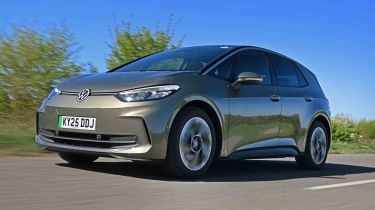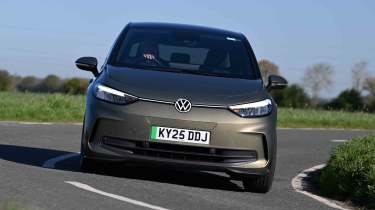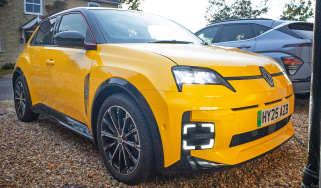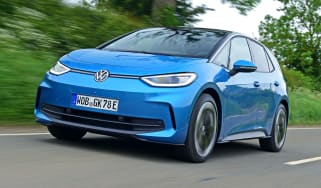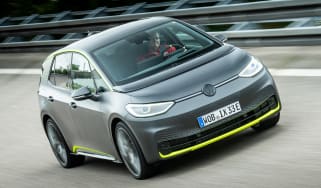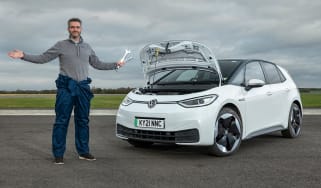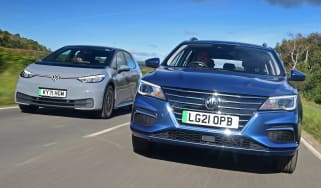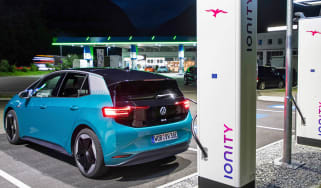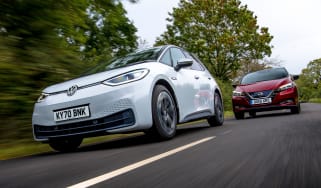Volkswagen ID.3 review
The Volkswagen ID.3 is a decent electric hatchback with a few niggles that hold it back

Our opinion on the Volkswagen ID.3
Think of the Volkswagen ID.3 as an electric Golf, and you won’t be too far off the mark. It certainly has the traits of VW’s ubiquitous hatchback, and a lot of the tech on board will be familiar to modern Golf drivers, while its all-electric powertrain and dedicated EV platform deliver a good driving range and composed performance. Practicality is strong, despite the car’s size, while an early facelift helped to rectify some of the criticisms at launch. There are still quirks in the infotainment system that take some getting used to, though, and higher-spec models look expensive when compared with rivals.
| Key specs | |
| Fuel type | Electric |
| Body style | Five-door hatchback |
| Powertrains | 52kWh battery 59kWh battery 79kWh battery |
| Safety | Five-star Euro NCAP (2020) |
| Warranty | Three years/60,000 miles |
About the Volkswagen ID.3
When it was first launched, the Volkswagen ID.3 was tasked with attracting buyers to electrification, with the hope that they might ultimately hold it in the same esteem as its classic Beetle and Golf name plates. Things haven’t panned out that way so far, but the ID.3 was the first of a wave of electric ID models from the brand that now cover a number of classes.
An early update in 2023 fixed some of the criticisms levelled at the car, with softer materials in the cabin, a revised look and updated infotainment tech, but the ID.3 still struggles to be a defining model in the electric hatchback sector.
Used - available now
For now, the ID.3 is the entry point to Volkswagen’s ID line-up, with prices starting at just under £31,000 for the base model. VW offers three battery options in the ID.3 called Pure (52kWh), Pro (59kWh) and Pro S (79kWh), with Essential and Match trims available for each battery. There’s a price difference of around £1,400 for the Pure model, but less than £1,000 between Pro versions and around £750 between the Pro S trims.
At the top of the range is the Volkswagen ID.3 GTX, which comes with the Pro S battery but a lot more power. It’s the hot model of the line-up, but it can’t quite cut it as an electric Golf GTI, while a price tag in excess of £46,000 means it’s significantly more expensive than the rest of the line-up.
All versions of the ID.3 are based on a five-door hatchback body, and are rear-wheel drive – courtesy of a rear-mounted electric motor.
The Volkswagen ID.3 is part of a growing number of cars being eligible for the Government's Electric Car Grant (ECG) announced in July 2025. The ID.3 qualifies for the £1,500 grant, which is applied automatically when you purchase.
If you're interested in getting yourself a Volkswagen ID.3, we can help. Configure your ideal Volkswagen ID.3 now to get top offers from local dealers, check out the latest Volkswagen ID.3 leasing deals or search for used Volkswagen ID.3 models with our Buy A Car service. You can even sell your existing car for a great price with Auto Express Sell My Car.
Performance & driving experience
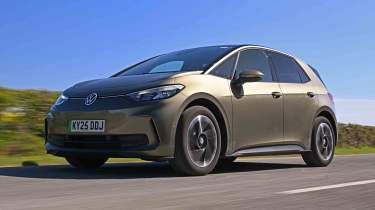
| Pros |
|
| Cons |
|
The ID.3 follows the classic Beetle with a rear-engine, rear-wheel-drive layout, although the modern underpinnings place everything within the car’s wheelbase, so there’s no risk of snap oversteer if you’re heavy with the throttle. All versions have a single electric motor, and the rear-drive layout is designed for packaging rather than driving fun, but it does have a bearing on the ID.3’s behaviour.
Electric motors, 0-60mph acceleration and top speed
Cars fitted with the Pure (52kWh) battery have 168bhp, while the Pro and Pro S versions have 201bhp. The fastest of these is the 59kWh Pro, with a 0-62mph time of 7.6 seconds. The extra weight of the Pro S’s 79kWh battery means it matches the Pure’s 0-62mph time of 8.2 seconds, which is still a decent turn of speed for a family hatchback.
At the top of the range, the GTX packs 322bhp and manages 0-62mph in a searing 5.7 seconds. Standard versions of the ID.3 are limited to 99mph, while the GTX has a top speed of 124mph.
Town driving, visibility and parking
While other rear-drive models take advantage of the lack of driveshifts up front to add a tight turning circle, the ID.3 has a fairly conventional 11.5-metre turning radius. The steering wheel is light at low speeds, though, and the responsive chassis means the car is easy to manoeuvre. All models come with front and rear parking sensors for added peace of mind, although a rear camera is only standard on Match trim.
Even the low-powered ID.3 is responsive, while the throttle is easily controlled. One quibble we have is with the ride, which can feel unsettled at lower speeds. It’s not enough to be considered uncomfortable, though.
B-road driving and handling
At higher speeds the ID.3’s ride improves, while a lack of wind and road noise means refinement is decent and the car offers a good balance between ride comfort and body control. It’s not exactly what you’d call fun, but the lighter weight of the small-battery Pure model helps the ID.3 feel relatively agile, and when accelerating hard out of a corner you can feel the rear-drive layout push the car gently without the risk of the tyres breaking traction.
Motorway driving and long-distance comfort
With 310Nm of torque on tap as soon as you press the accelerator, even the lowest-powered ID.3 has no trouble getting up to higher speeds. There’s still enough flexibility in the powertrain to help with overtaking, too, while the ride is smooth and the cabin remains hushed at higher speeds.
“You don’t really need a sub-10 second 0-60mph time from a family hatchback, so for that reason I’d happily stick with the newer Pure model. It still manages the sprint in a little over eight seconds, while weight savings of 35kg and 170kg over the Pro and Pro S versions, courtesy of the smaller capacity battery, boost the car’s agility.” – Dean Gibson, senior test editor
| Model | Power | 0-60mph | Top speed |
| Pure | 168bhp | 8.2s | 99mph |
| Pro | 201bhp | 7.6s | 99mph |
| GTX | 322bhp | 5.7s | 124mph |
Range, charging & running costs
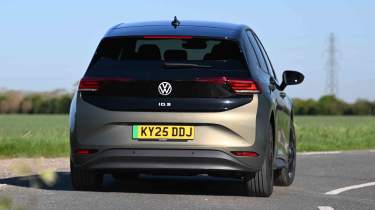
| Pros |
|
| Cons |
|
The combination of the Pure battery and Essential trim has helped reduce the starting price of the ID.3, while everyday running costs should be reasonable, too.
Electric range, battery life and charge time
With a 52kWh battery on board, the ID.3 has an official range of up to 241 miles. In comparison, the Citroen e-C4 manages 219 miles with a 50kWh battery, or 257 miles with a 54kWh pack, so the ID.3 is pretty competitive.
When we tested the Pure model in Match trim we saw an average of 4.1 miles per kWh, which was pretty good considering the number of motorway miles that were covered – the car’s slippery shape helps in this regard. That translated into a range of 213 miles, which was around 30 miles short of the official claim, but still a decent enough range for most needs in a day.
The larger 59kWh Pro battery has a range of up to 269 miles, while the 79kWh Pro S can travel up to 351 miles on a full charge, and the GTX can manage up to 369 miles with the same battery as the Pro S.
Maximum charging rates for the ID.3 vary according to which battery you choose; the 5kWh pack has a top rate of 145kW, while the Pro can charge at up to 165kW DC and the Pro S and GTX manage 185kW. The net result is that DC charging will take each pack from 10-80 per cent capacity in 24-26 minutes.
When it comes to topping up at home, a typical 7.4kW home wallbox will fully replenish the ID.3 Pro’s 58kWh battery in just over nine hours, or roughly 12 hours for the 77kWh ID.3 Pro S.
No ID.3 comes with a heat pump as standard. If you want to add one to help maintain range in cold weather, it’ll cost you more than £1,000.
| Model | Battery size | Range | Insurance group |
| Pure | 52kWh | 241 miles | 20 |
| Pro | 59kWh | 269 miles | 26 |
| IGTX | 79kWh | 369 miles | 34 |
Insurance groups
Group ratings for the ID.3 align with the powertrains offered, so Pure cars are in group 20, Pro in group 26, Pro S in group 30 and GTX in group 34. Essential and Match trims have the same ratings.
Tax
With a three per cent Benefit-in-Kind rate for electric vehicles, company car rates will boil down to list prices, so the entry-point Pure versions of the ID.3 will be the best for business users. Expect a liability starting from £185 for the 2025/26 tax year.
All versions of the ID.3 bar the top-spec GTX fall below the luxury car tax barrier, although the Pro S versions are only just under £40,000, so adding extras will see them fall into the £620 road tax bracket for years 2-6.
Depreciation
The best performing ID.3 when it’s time to sell on is the entry-level Pure model, which holds on to half of its list price after three years and 36,000 miles.
Essential versions of the Pro S model are at the other end of the scale with residuals of around 43 per cent, while the fast GTX retains 45 per cent of its value after three years. These figures are slightly better than for the platform-sharing Cupra Born and well ahead of the Citroen e-C4.
To get an accurate valuation for a specific model, check out our free car valuation tool...
Interior, design & technology

| Pros |
|
| Cons |
|
When it was unveiled in 2019, the Volkswagen ID.3 had a friendly face, but the brand decided to give it a more aggressive look as part of the 2023 facelift. It also received a new front bumper, and the black panel at the base of the windscreen has been removed, which makes the bonnet look longer and better proportioned. Tweaks to the rear include revised tail-lights with an X motif when illuminated. Overall, the changes are relatively subtle, but they help give the ID.3 slightly more kerb appeal.
Interior and dashboard design
The very minimalist interior of the ID.3 has been a source of constant criticism since the car launched, with the cheap-feeling materials, infuriating touch-sensitive climate controls and fiddly infotainment system bringing the car down. However, the 2023 update brought improved quality, with softer plastics and textured trim helping to give the cabin a lift.
Materials and build quality
Adding these new materials definitely boosted the ID.3’s appeal and the air of quality inside. Base Essential and Match models come with cloth upholstery, but the two-tone finish and wave-like stitching help to break up the monotone looks inside, while the soft dashboard with stitched edges also adds to the more upmarket ambience. One glaring omission that would give the ID.3 a boost (and makes the Golf feel like a quality product) is flock-lined door bins – in basic models they’re just bare plastic, so loose items rattle around.
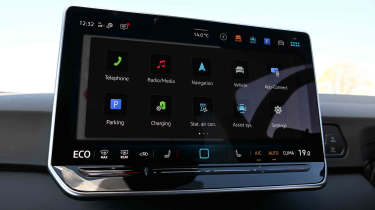
Infotainment, sat-nav and stereo
The ID.3 has been given a tech boost, with all models now featuring a 12.9-inch screen, although the amount of functionality it has depends on the trim level chosen, with Discover Pro navigation only standard with Match trim and above. Permanent climate controls are situated along the bottom of the display. Thanks to the screen’s size, they’re easy to use when you’re on the move.
The built-in software works reasonably well, with smart routing for sat nav-equipped cars (you can ‘unlock’ navigation on lower-spec models by paying extra for it via the screen), but some of the sub menus seem showy for no real reason – we’d like a simpler looking set-up.
Connectivity includes four USB-C sockets in the cabin, which are all mounted on the central armrest – two between the front seats and a pair at the back for rear occupants.
One oddity that still remains in the ID.3 is the dual-function window switches on the driver’s door: instead of having four controls, there are only two, plus a button that switches between front and rear. It seems like a solution to a question that has never been asked.
“Adding options involves paying for some pricey packs instead of individual items. VW’s smart looking head-up display comes with either the Driver Assistance Pack (£1,175 ) or the Assistance Package Plus (£2,240), which also adds semi-autonomous driving tech that can change lanes, plus adds a memory function and remote operation to the car’s parking software. If you want improved driving dynamics, the £955 Sports package adds VW’s DCC Dynamic Chassis Control and progressive steering for sharper responses.” – Dean Gibson, senior test editor
Boot space & practicality
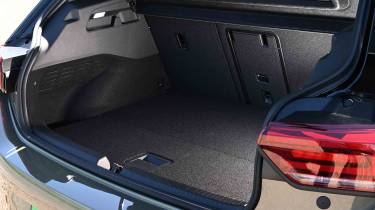
| Pros |
|
| Cons |
|
The five-door ID.3 is easy to get in and out of, and once you’re sitting in the cabin, you’ll immediately notice the extra space compared with the current Volkswagen Golf. Comfortable seats with standard armrests make it a relaxing place to spend time in, while the pared-back interior contributes to the feeling of space. Visibility is generally good, although, much like the Cupra Born, the chunky front pillars can be awkward to look around at tight junctions.
Dimensions and size
The Volkswagen ID.3 is roughly the same size as its Golf sibling. Or to be precise, at 4,261mm long, 1,809mm wide and 1,568mm tall, the ID.3 is 135mm shorter than the Mk8 Golf, but 20mm wider and 77mm taller. The MG4 is slightly larger overall, but only just, while the ID.3’s sister car, the Cupra Born, is longer and lower than the VW. If you’d like a more SUV-style look, then the Citroen e-C4 is more of a high-riding hatchback/crossover, but offers a similar amount of space inside as the ID.3.
| Dimensions | |
| Length | 4,264mm |
| Width | 1,809mm |
| Height | 1,564mm |
| Number of seats | Five |
| Boot space | 385-1,267 litres |
Driving position, seats & space in the front
There’s a wide range of wheel and seat adjustment, and the compact instrument cluster ahead of the driver moves with the steering wheel, so is always in line of sight.
Storage is fine, with slender door bins, two open cup holders, slot and cargo net storage for smartphones, and a tray between the front seats with a sliding cover, while there are individual armrests for the front seats. The glovebox is frustratingly narrow, though, due to the location of fuses – it’s an unusual quirk to find in a VW, as usually this set-up is reserved for models from French car makers.
Seats & space in the back
At launch the ID.3 came in four or five-seat configurations, but today all models have three seatbelts in the back. Space is fine, although it feels a little narrow when travelling three up, while there’s enough room for feet courtesy of the flat floor and plenty of space under the front seats. The middle seat folds down to reveal two cup holders, while there’s a ski hatch in the seat back for longer items.

Boot space
There’s a 385-litre boot with the rear seats in place, which is four litres larger than a Mk8 Golf, but some electric hatch rivals offer more capacity. There’s no additional storage under the bonnet. A false boot floor is a £75 option on lower-spec cars and standard further up the range, and this lets you tidily stow away the charging cables, as well as create a level loading area when the back seats are folded. With the false floor removed and the rear seats down, the ID.3 has 1,267 litres of space.
“Towing isn’t an option with the ID.3, although Volkswagen does offer a tow hitch preparation as an optional extra. This is so you can fit a cycle carrier to the back of the car. The mounts are located behind the number plate.” – Dean Gibson, senior test editor. Tested the ID.3 against the Citroen e-C4 in a twin test.
Reliability & safety
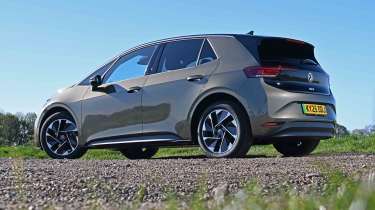
| Pros | Cons |
|
|
The ID.3 was awarded a five-star crash safety rating by Euro NCAP in 2020. Adult and child occupants were deemed to be well protected with scores of 87 and 89 per cent, respectively, while the ID.3’s Safety Assist score of 88 per cent was also decent.
Standard safety kit includes a driver fatigue alert system, dynamic traffic sign display, Lane Assist, adaptive cruise control, parking sensors front and rear, and autonomous emergency braking (AEB) with cyclist and pedestrian monitoring. As with all electric cars, the ID.3 emits an artificial noise at low speeds to warn cyclists and pedestrians of its presence.
More driver-assistance tech is available on the options list. The Driver Assistance Pack (around £1,200 extra on some models, but standard on others) includes Park Assistance Plus, a reversing camera and a proactive passenger protection system, which prepares the seatbelt tensioners in advance of a collision. The Assistance Package Plus (£2,250) also adds an area-view camera set-up, lane change assist and Volkswagen’s semi-autonomous Travel Assist system. Adding one of the Interior Comfort Packs (£2,500 or £3,900 for the Top Sport Plus package) can also get an augmented-reality head-up display.
| Key standard safety features | Euro NCAP safety ratings |
|
|
Buying and owning
- Best buy: Volkswagen ID.3 Pure Match
The entry-level ID.3 offers the best value in our eyes. It comes with plenty of standard kit, while the modest 52kWh battery in Pure models delivers good efficiency and range when compared with models at a similar price point.
Volkswagen provides a three-year/60,000-mile warranty, while the ID.3’s battery is covered for eight years or 100,000 miles. All VW’s EVs have three years of roadside assistance, compared with 12 months for all combustion models bar the Volkswagen Touareg SUV.
The ID.3’s servicing schedule commences after two years, irrespective of the mileage covered, then services take place every year or 20,000 miles. VW has a range of service plans available to help you pay for it.

Alternatives
The most obvious rival for the ID.3 is the Cupra Born, which is largely the same car but with a sportier set-up and arguably sharper looks. At the value-driven end of the line-up, you could also consider the Citroen e-C4, MG4 or possibly even the new Renault 4, which is a similar size. Other options include the Renault Megane E-Tech, Kia Niro EV and Hyundai Kona Electric, while the Peugeot 308 and Vauxhall Astra offer either electric or combustion engine options. If petrol is more to your liking, then of course there are conventional five-door hatchbacks such as the Golf, Toyota Corolla and Honda Civic.
Deals on the Volkswagen ID.3 and alternatives
Volkswagen ID.3 Pro S long-term test

Our chief sub-editor, Andy Pringle, spent six months with the Volkswagen ID.3 as part of our long-term fleet. It was the first time he’s had the keys to an all-electric car, and he was left feeling very impressed with how simple the VW is to drive. The smooth and refined powertrain makes it the perfect urban runabout for him and his family, and he’s convinced that it’d make a great starting point for any EV newbies.
However, despite improvements to the much-maligned infotainment system, Andy still felt that it was far from perfect, and quickly became frustrated with how long it took to complete simple actions. You can read the full long term test here…
Volkswagen ID.3 pictures
Frequently Asked Questions
While it’s not the genre-defining model that Volkswagen had hoped for, the ID.3 is still a decent electric family hatchback. There are rivals that do things a bit better, though, and prices can get steep at the top of the range. We’d keep things simple with the Pure model in Match trim to help keep costs down.
